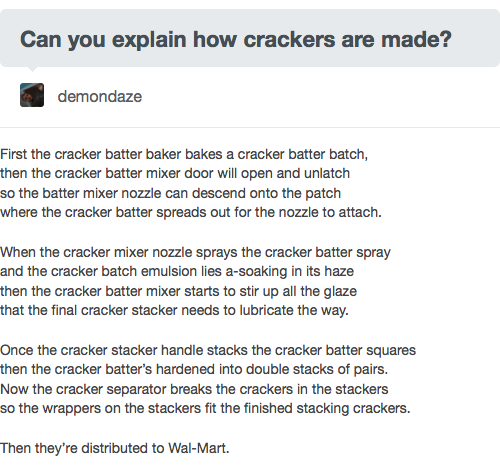I am a husband, father, martial artist, physician, and US Army soldier. I'm a helpless fanatic of all things martial arts with 20+ years experience in Eclectic Goju-Ryu karate as well as 10+ years in Medieval German swordsmanship. Follow along at your own risk, Side effects vary. Occasionally there's health and fitness posts, anatomy related art, or personal posts from things I enjoy.
Don't wanna be here? Send us removal request.
Text
Anyway, do you guys want to see my Cool Rocks?

This is my grandfather’s rock. It is Probably a Garnet, which he mined out himself when he was in college studying to be a geologist.

Though you may assume this is a Small Rock, it is in fact a very Large Rock, and also a very Heavy Rock, but most especially a very Square Rock, which is what makes it particularly cool.

Here we have a rock which used to be a tree. This rock is petrified wood! It was one of my very first Cool Rocks!

Speaking of rocks that used to be things that were not rocks, this rock is Petoskey stone! This rock used to be a coral. Let’s get a good look at those patterns.

Now that’s a Cool Rock!

Amethyst? It’s an Okay Rock. If you are looking for an inexpensive rock to start your collection, amethyst is the way to go. It’s a quartz with a deep purple color. A very nice, if average, rock.

Now citrine… Citrine is a Cool Rock! It’s a smoky quartz with a lovely honey color. The druzy on my chunk of citrine has a wonderful sparkle.

This is my Amazonite! It grew that hexagon shape all by itself!! This specimen is from Colorado.

Look at this shiny little slice of rock! This rock is Tiger Iron, and those bands of red and orange glow beautifully with some light behind them. These different colored bands are made from Hematite (the dark silver), Jasper (the red-orange), and Tiger-Eye quartz (the yellow-orange).

Here’s a rock you’ve probably seen before! This Cool Rock is Malachite. The patterns and rings are from the stalagmites this little egg was carved from.

Whoa, look at this giant slab of Extremely Cool Rock!!! These crystals formed in the cracks of fossilized mud, to make the awesome patterns in this geode of Septarian! This is my second best rock.

This is my Best and most Favorite Cool Rock. In this dark room it’s a dull little grey rock, but if I move it closer to the light…

Those glints of gold! Those veins of blue! This rock is most certainly Labradorite, which changes color spectacularly when the light hits it just right. Let’s put it in direct sunlight.

Yes!! YES!! There it is!! The Best and Coolest Rock!!!!!
147K notes
·
View notes
Text
Gichin Funakoshi's Twenty Precepts of Karate

1. Karate-do begins with courtesy and ends with rei.
2. There is no first strike in karate.
3. Karate is an aid to justice.
4. First know yourself before attempting to know others.
5. Spirit first, technique second.
6. Always be ready to release your mind.
7. Accidents arise from negligence.
8. Do not think that karate training is only in the dojo.
9. It will take your entire life to learn karate, there is no limit.
10. Put your everyday living into karate and you will find “Myo” (subtle secrets).
11. Karate is like boiling water, if you do not heat it constantly, it will cool.
12. Do not think that you have to win, think rather that you do not have to lose.
13. Victory depends on your ability to distinguish vulnerable points from invulnerable ones.
14. The outcome of the battle depends on how you handle weakness and strength.
15. Think of your opponents hands and feet as swords.
16. When you leave home, think that you have numerous opponents waiting for you.
17. Beginners must master low stance and posture, natural body positions are for the advanced.
18. Practicing a kata exactly is one thing, engaging in a real fight is another.
19. Do not forget to correctly apply: strength and weakness of power, stretching and contraction of the body, and slowness and speed of techniques.
20. Always think and devise ways to live the precepts of karate-do every day.
411 notes
·
View notes
Video
6K notes
·
View notes
Text
“There are days that I cannot find the sun even though its right outside my goddamn window.”
—
Neil Hilborn
(via purplebuddhaquotes)
537 notes
·
View notes
Text
it fucking pisses me off so much that the pieces of exodia card art don’t connect together in any way
79K notes
·
View notes
Text
Karate: Retracing Our Steps.
Most of us know about how Funakoshi is the fatherof modern day Karate, and that he was responsible for sending Karate teachersto the west and other parts of the world to teach. But who did he learn from? And in turn, who did they learn from? and so on. Well, I decided to do a little backtracking on this, as far back as possible, hoping to find the Chinese monks.

Now, we know that Bodhidharma, a Hindu monk, is said to be the one who started passing around the art of self defense to young, homeless children, during his travels through China, where he decided to stay and open up a monastery for these young kids, whom he called Shaolin, and many years later, monks from the Shaolin, spread their art and knowledge on their travels. Some of these monks went to the Ryukyu Islands, where they taught their art called Chuan Fa (Kenpo in Japanese).
This is where I want to try to backtrack to. There’s some info on each of the masters mentioned here, but I want to encourage everyone to research each one, or those who interest you most, so that you guys can learn more about who they were and what they did. For this reason, I’m not posting links either. Can’t make it too easy now. =]

Starting back from Gichin Funakoshi’s teachers: Anko Itosu and Anko Azato.

Anko Azato (1827 – 1906) - Not much is known about him. Whatever information can be found is based on Funakoshi’s descriptions of him. Azato was described by Funakoshi as “One of Okinawa’s greatest experts in the art of Karate”. According to Funakoshi, Azato was also a skilled Archer and horse rider, an adept in the art of Jigen Ryu Kendo, and was an exceptional scholar.

Anko Itosu (1831 – 1915) was small in stature, very shy and introverted in his youth. As an adult, he was secretary to the last king of Okinawa, before the Japanese abolished the Okinawan monarchy in 1879.
He began his study in the art of Tode (Karate today) under Nagahama city’s Chikudun Pechin (Okinawan term for the scholar-officials class of the former Ryukyu Kingdom (modern-day Okinawa), the class equivalent of the Japanese Samurai.), but was later on taught, alongside Azato, by Sokon Matsumura.
Itosu helped introduce Karate into Okinawa’s schools. In 1905, he was a teacher of Tode at the First Junior Prefectural High School, where he developed the method of teaching techniques that are still used to this day, by creating the five Pinan, or Heian, so that the students could learn in an easier manner, as he felt that the old forms were too difficult for children. He’s also credited with breaking down the Naihanchi, or Tekki, into the three forms that we know today. In 1908, he wrote the “Tode Jukun” (Ten Precepts of Karate) in a letter to the Ministry of Education and the Ministry of War in Japan, in order to gain their attention.
The letter with the precepts read as follows:

Karate did not develop from Buddhism or Confucianism. In the past the Shorin-ryu school and the Shorei-ryu school were brought to Okinawa from China. Both of these schools have strong points, which I will now mention before there are too many changes:
1. Karate is not merely practiced for your own benefit; it can be used to protect one’s family or master. It is not intended to be used against a single assailant but instead as a way of avoiding a fight should one be confronted by a villain or ruffian.
2. The purpose of karate is to make the muscles and bones hard as rock and to use the hands and legs as spears.
If children were to begin training in Tang Te (Chinese Hand) while in elementary school, then they will be well suited for military service. Remember the words attributed to the Duke of Wellington after he defeated Napoleon: “The Battle of Waterloo was won on the playing fields of Eton.”
3. Karate cannot be quickly learned. Like a slow moving bull, it eventually travels a thousand miles. If one trains diligently every day, then in three or four years one will come to understand karate. Those who train in this fashion will discover karate.
4. In karate, training of the hands and feet are important, so one must be thoroughly trained on the makiwara. In order to do this, drop your shoulders, open your lungs, take hold of your strength, grip the floor with your feet, and sink your energy into your lower abdomen. Practice using each arm one to two hundred times each day.
5. When one practices the stances of Tang Te, be sure to keep your back straight, lower your shoulders, put strength in your legs, stand firmly, and drop your energy into your lower abdomen.
6. Practice each of the techniques of karate repeatedly, the use of which is passed by word of mouth. Learn the explanations well, and decide when and in what manner to apply them when needed. Enter, counter, release is the rule of releasing hand (torite).
7. You must decide if karate is for your health or to aid your duty.
8. When you train, do so as if on the battlefield. Your eyes should glare, shoulders drop, and body harden. You should always train with intensity and spirit, and in this way you will naturally be ready.
9. One must not over-train; this will cause you to lose the energy in your lower abdomen and will be harmful to your body. Your face and eyes will turn red. Train wisely.
10. In the past, masters of karate have enjoyed long lives. Karate aids in developing the bones and muscles. It helps the digestion as well as the circulation.
If karate should be introduced beginning in the elementary schools, then we will produce many men each capable of defeating ten assailants.
I further believe this can be done by having all students at the Okinawa Teachers’ College practice karate. In this way, after graduation, they can teach at the elementary schools at which they have been taught. I believe this will be a great benefit to our nation and our military. It is my hope you will seriously consider my suggestion.
- Anko Itosu, October 1908
This letter was influential in the spread of karate.
Itosu’s style, Shorin Ryu, became known as Itosu Ryu, in recognition of his skills, mastery, and role as teacher.

Sokon Matsumura (1797 - 1889) began his study of Tode under the guidance of Sakugawa Kanga. Matsumura had reputation as an expert martial artist, even as a young man. He was recruited into the service of the royal family of the Ryukyu Kingdom in 1816. He became the chief martial arts instructor and bodyguard for the Okinawan King, and later served in the same role for the last two Okinawan kings. Matsumura traveled to China. While he was in China, he studied Chuan Fa at the Shaolin Monastery, and later brought what he learned, back to Okinawa, helped to further develop karate, and was later known as the “Forefather of Shorin Ryu”, as he went on to develop the Shuri-Te which later developed into Shorin Ryu Karate.
Side note: In 1818, Matsumura Married Yonamine Chiru, who was also a martial arts expert, and it was said that she would lift up 130 pound sacks of rice, to sweep the floor underneath. It was also said that she wouldn’t marry anyone who couldn’t defeat her. Supposedly, time and again, men tried, but failed. She married Matsumura, although it isn’t known if they ever did fight.

Sakugawa Kanga (also known as Tode Sakugawa) (1733 - 1815) was a martial arts master, who played a major role in the development of Te, the precursor to modern day Karate. Sakugawa trained under the monk, Peichin Takahara, beginning in 1750, for six years, after which Takahara sent Sakugawa to train under Kusanku, a Chinese master in the art of Chuan Fa, for six more years. It is said that he combined Chuan Fa with his first master’s style, forming what became known as Okinawa-te. After his training under Kusanku, he began teaching the art. He was so recognized as an expert that he was given the name To-de Sakugawa (Sakugawa “Chinese Hand”) by Takahara. He is considered to be the “Father of Okinawan Karate”, and his Okinawa-te became the base for his most famous student’s (Matsumura) Shuri-Te. Sakugawa passed down to his students the kata Kusanku, said to be one of Okinawa’s oldest kata, and developed the Bo kata, Sakugawa no Kon.

Peichin Takahara (1683 - 1760) was a Buddhist monk, mapmaker and astronomer, belonging to an upper class family from Shuri. The word Peichin isn’t a name, but a title similar to that of “Knight” given to some regents of the Court of Shuri. Takahara was known as a martial arts expert, he was highly respected as a great warrior, and his teacher was Chatan Yara. Takahara regarded the martial arts as a way of life, and is attributed to have been the first to explain the principles of Do (Way):
1. Ijo - Compassion, Humility and Modesty.
2. Fo - Seriousness, Devotion and Dedication.
3. Katsu - Deep understanding of techniques and forms.
Kusanku (Kwang Shang Fu) (1670 - 1762) was a Chinese martial arts master, who learned the art of Chuan Fa in China from a Shaolin Monk. He is credited as having an influence on practically every martial arts derived from Karate. Around 1756, Kusanku was sent, as an ambassador of the Qing Dynasty, to Okinawa, where he lived in Kanemura, near the city of Naha. During his stay in Okinawa, he instructed Sakugawa Kanga from 1756 to 1762, the year he died. After his death, Sakugawa developed, and named, the kata Kusanku, in honor of his teacher.
Chatan Yara (1668 - 1756) was known as being one of the first to spread the art of Te throughout Okinawa. At the age of 12, Yara’s parent’s sent him to China to study the Chinese language and martial arts. During his time in China, he mastered the use of the Bo and Sai while studying under the guidance of his teacher, Wong Chung-Yoh. In 1700, he returned to Shuri. Shortly after, he assisted a woman who was being harassed by a Samurai. After avoiding the Samurai’s attack, Yara took an oar from a nearby boat and used it as a weapon. He successfully disarmed and killed the Samurai. Hearing of this daring rescue, local officials recruited Yara to teach martial arts to the locals for the purpose of self defense.
Wong Chung-Yoh (1630 - ????) Very little is known about this man. He was a teacher of a martial art style called Xing Yi Quan, also known as Hsing. His school was located in Fuzhou, in the Fukien Province in China. His most notable student, who produced the lineage for modern Karate, was Chatan Yara.
—-
Up to here, Gichin Funakoshi’s direct lineage is over, or seems to be, at least by what I’ve been able to trace back. But remember, there were other masters that aren’t as notable as the ones mentioned here, not to mention their students. So this is in no way saying that these are the ones and only, but it is more than clear that all karate styles come from the same root, the Chinese martial art, Chuan Fa.
—-
Another master from Okinawa worth mentioning:
Matsu Higa Peichin (1640 - 1720) was a legendary martial artist who influenced the development of Karate and Kobudo, especially in the art of the Bo (staff). He was a student of the Chinese emissary, Wanshu, who taught him Chuan Fa. Legend states that Matsu Higa, with his Bo, stood up to the head-hunters of Formosa, and to Japanese pirates from the north, and never lost a battle. His contributions live on in several weapons kata, especially for Tonfa, Sai, and Bo: Matsu Higa no Tonfa, Matsu Higa no Sai and Matsu Higa no Kon.
Wanshu (Wang) (1621 - 1689) - Wang was the leader of an ambassadorial mission from China, sent by the Qing government in 1683 to the village of Tomari. He was a diplomat, poet, calligrapher, and a martial artist of Shaolin White Crane. He is credited with having taught Chaun Fa to the gentry of Tomari. The kata Wanshu was either created by Wang, or his students developed it in his honor. Whichever the case, this kata is practiced to this day in many styles of karate under the name Wanshu, Anshu, Unsu and Empi (Gichin Funakoshi renamed it Empi for use in his school). The two main versions of this kata are Matsumura’s and Itosu’s versions. This kata is also practiced in various Korean styles such as Tang Soo Do and Soo Bak Do. They also have veried names for this kata: Wangshū, Wang Shu, or Yun Bi in Korean. This kata is often reserved for advanced students, because of its difficulty.
—-
So in the end, my friends, there’s no absolute Way. Remember that next time somebody tells you about how their styles are the only truth.
I hope you’ve enjoyed this post! =]
843 notes
·
View notes
Note
Why did Knights in full plated armor fight eachother with swords if they cant harm the enemy
Ah ! Well to keep it short, they didn’t when they could help it. The sword was a sidearm then, and knights in full plate harness most often fought with larger polearms designed to bash, pry and poke their opponent appart.

-mod Burgonet
1K notes
·
View notes
Text
Anyway, do you guys want to see my Cool Rocks?

This is my grandfather’s rock. It is Probably a Garnet, which he mined out himself when he was in college studying to be a geologist.

Though you may assume this is a Small Rock, it is in fact a very Large Rock, and also a very Heavy Rock, but most especially a very Square Rock, which is what makes it particularly cool.

Here we have a rock which used to be a tree. This rock is petrified wood! It was one of my very first Cool Rocks!

Speaking of rocks that used to be things that were not rocks, this rock is Petoskey stone! This rock used to be a coral. Let’s get a good look at those patterns.

Now that’s a Cool Rock!

Amethyst? It’s an Okay Rock. If you are looking for an inexpensive rock to start your collection, amethyst is the way to go. It’s a quartz with a deep purple color. A very nice, if average, rock.

Now citrine… Citrine is a Cool Rock! It’s a smoky quartz with a lovely honey color. The druzy on my chunk of citrine has a wonderful sparkle.

This is my Amazonite! It grew that hexagon shape all by itself!! This specimen is from Colorado.

Look at this shiny little slice of rock! This rock is Tiger Iron, and those bands of red and orange glow beautifully with some light behind them. These different colored bands are made from Hematite (the dark silver), Jasper (the red-orange), and Tiger-Eye quartz (the yellow-orange).

Here’s a rock you’ve probably seen before! This Cool Rock is Malachite. The patterns and rings are from the stalagmites this little egg was carved from.

Whoa, look at this giant slab of Extremely Cool Rock!!! These crystals formed in the cracks of fossilized mud, to make the awesome patterns in this geode of Septarian! This is my second best rock.

This is my Best and most Favorite Cool Rock. In this dark room it’s a dull little grey rock, but if I move it closer to the light…

Those glints of gold! Those veins of blue! This rock is most certainly Labradorite, which changes color spectacularly when the light hits it just right. Let’s put it in direct sunlight.

Yes!! YES!! There it is!! The Best and Coolest Rock!!!!!
147K notes
·
View notes
Photo

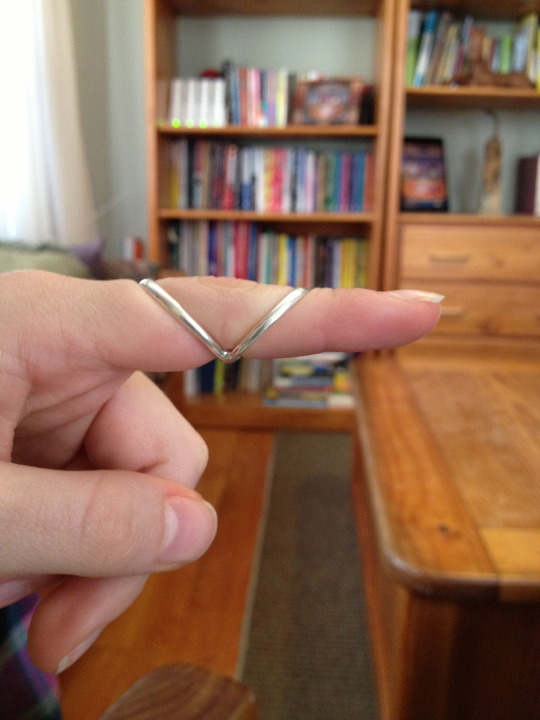
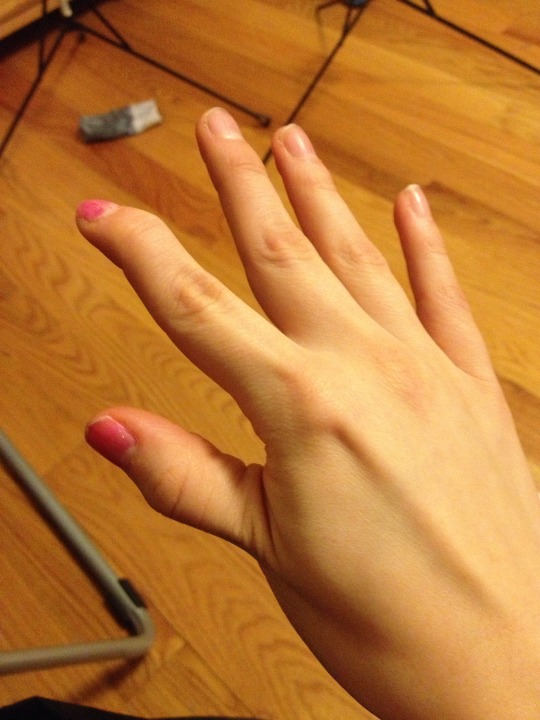

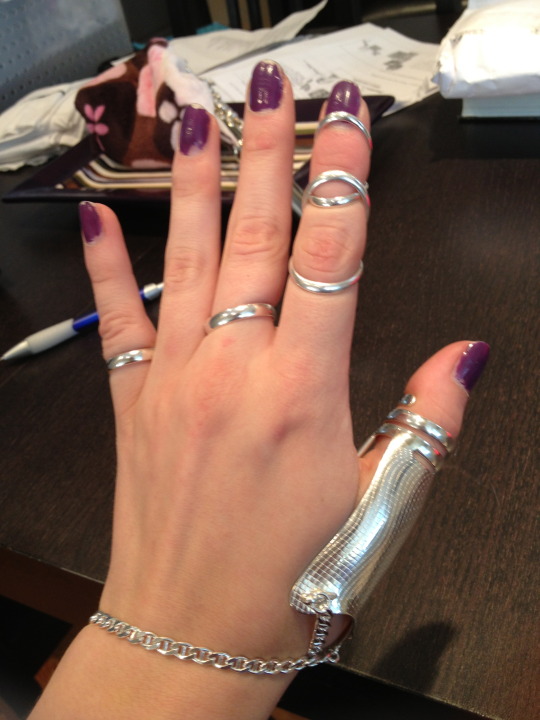
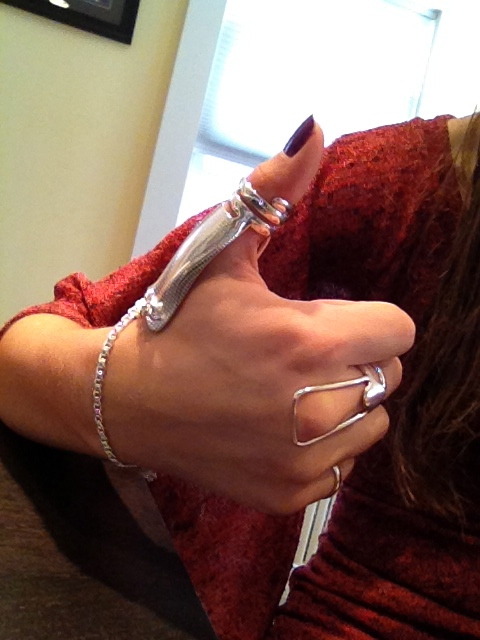
Having Ehlers Danlos Syndrome sometimes feels about the equivalent of being composed of jello and wet spaghetti. Nothing stays where its supposed to. Literally every single cell in the body is floppy, so fingers are definitely an issue for many of us. I can almost guarantee that for the majority of us, writing is not only slow and painful but nearly impossible at times. FIne motor skills? What even are those? An EDSer surely doesn’t have any of those. Even typing which is far easier than writing, is painful and daunting at times. But last year I joined the population of shiny zebras by getting fitted for a set of Silver Rings Splints and they are beyond magical.
For those of you who have not heard of The Silver Ring Splint Company, they are a company that custom makes finger splints that look like elegant pieces of jewelry. Don’t believe me? Well I can’t even tell you how many compliments I’ve received for them. Nobody even suspects that they might possibly be medical. But more importantly, they work amazing! I still have hand pain and finger dislocations when performing fine motor skills and writing is definitely not something I look forward to but I have saved myself thousands of painful dislocations, I can open doors easier, type faster, write longer and hold objects in my hands without looking like an alien from a sic-fi movie. With the rings on my fingers actually look like fingers rather than tentacles!
The company is also family owned and the people are so sweet and helpful!
If you are having trouble with hand pain, clumsiness and dislocations please check out this amazing company!
http://www.silverringsplint.com
266K notes
·
View notes




